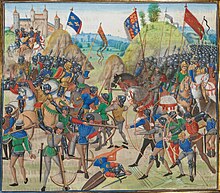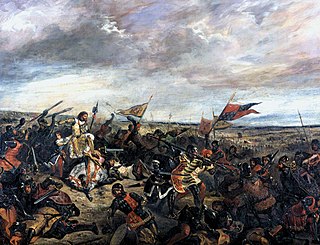
The Battle of Poitiers was fought on 19 September 1356 between a French army commanded by King John II and an Anglo-Gascon force under Edward, the Black Prince, during the Hundred Years' War. It took place in western France, 5 miles (8 km) south of Poitiers, when approximately 14,000 to 16,000 French attacked a strong defensive position held by 6,000 Anglo-Gascons.

The Battle of Agincourt was an English victory in the Hundred Years' War. It took place on 25 October 1415 near Azincourt, in northern France. The unexpected English victory against the numerically superior French army boosted English morale and prestige, crippled France, and started a new period of English dominance in the war that would last for 14 years until England was defeated by France in 1429 during the Siege of Orléans.

The Battle of Bouvines was fought on 27 July 1214 near the town of Bouvines in the County of Flanders. It was the concluding battle of the Anglo-French War of 1213–1214. Although estimates on the number of troops vary considerably among modern historians, at Bouvines, a French army commanded by King Philip Augustus routed a larger allied army led by Holy Roman Emperor Otto IV in one of the rare pitched battles of the High Middle Ages and one of the most decisive medieval engagements.

Charles Martel, Martel being a sobriquet in Old French for "The Hammer", was a Frankish political and military leader who, as Duke and Prince of the Franks and Mayor of the Palace to the Merovingian kings of the Franks, was the de facto ruler of the Franks from 718 until his death. He was a son of the Frankish statesman Pepin of Herstal and a noblewoman named Alpaida. Charles successfully asserted his claims to power as successor to his father as the power behind the throne in Frankish politics. Continuing and building on his father's work, he restored centralized government in Francia and began the series of military campaigns that re-established the Franks as the undisputed masters of all Gaul. According to a near-contemporary source, the Liber Historiae Francorum, Charles was "a warrior who was uncommonly ... effective in battle".

Poitiers is a city on the River Clain in west-central France. It is a commune and the capital of the Vienne department and the historical centre of Poitou. In 2017 it had a population of 88,291. Its agglomeration has 130,853 inhabitants in 2016 and is the center of an urban area of 261,795 inhabitants. It is a city of art and history, still known as "Ville aux cent clochers".

The Basilica of Saint-Denis is a large former medieval abbey church and present cathedral in the commune of Saint-Denis, a northern suburb of Paris. The building is of singular importance historically and architecturally as its choir, completed in 1144, is widely considered the first structure to employ all of the elements of Gothic architecture.

Denis of Paris was a 3rd-century Christian martyr and saint. According to his hagiographies, he was bishop of Paris in the third century and, together with his companions Rusticus and Eleutherius, was martyred for his faith by decapitation. Some accounts placed this during Domitian's persecution and incorrectly identified St Denis of Paris with the Areopagite who was converted by Paul the Apostle and who served as the first bishop of Athens. Assuming Denis's historicity, it is now considered more likely that he suffered under the persecution of the emperor Decius shortly after AD 250.

White flags have had different meanings throughout history and depending on the locale.

Geoffroi de Charny was the third son of Jean de Charny, the lord of Charny, and Marguerite de Joinville, daughter of Jean de Joinville, the biographer and close friend of France’s King Louis IX. A renowned knight who fought on the French side during the early years of the Hundred Years’ War, Charny wrote a semi-autobiographical poem, The Book of Geoffroi de Charny, and a set of questions on chivalric matters for the short-lived Company of the Star, France’s counterpart to England’s Order of the Garter. Although a prose treatise called the Book of Chivalry has also long been accredited to him, recent findings indicate this to have been more likely by his son of the same name, Geoffroi II de Charny, who died in 1398. Charny is also widely associated with the first known showings of the Shroud of Turin, though there are now doubts that he was responsible for these.

The Battle of Roosebeke took place on 27 November 1382 on the Goudberg between a Flemish army under Philip van Artevelde and a French army under Louis II of Flanders who had called upon the help of the French king Charles VI after he had suffered a defeat during the Battle of Beverhoutsveld. The Flemish army was defeated, Philip van Artevelde was slain and his corpse was put on display.
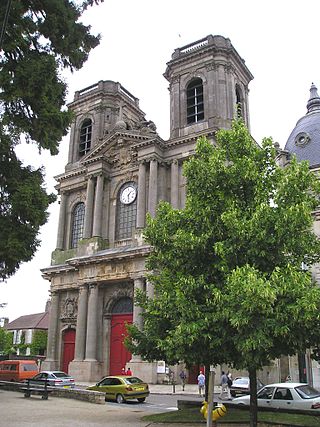
The Diocese of Langres is a Latin Church diocese of the Catholic Church comprising the département of Haute-Marne in France.

The Archdiocese of Sens and Auxerre is a Latin Archdiocese of the Catholic Church in France. The Archdiocese comprises the department of Yonne, which is in the region of Bourgogne. Traditionally established in sub-apostolic times, the diocese as metropolis of Quarta Lugdunensis subsequently achieved metropolitical status. For a time, the Archbishop of Sens held the title "Primate of the Gauls and Germania". Until 1622, the Metropolitan Archdiocese numbered seven suffragan (subordinate) dioceses: the dioceses of Chartres, Auxerre, Meaux, Paris, Orléans, Nevers and Troyes, which inspired the acronym CAMPONT. The Diocese of Bethléem at Clamecy was also dependent on the metropolitan see of Sens. On December 8, 2002, as part of a general reorganization of the dioceses of France undertaken, at least in part, to respond to demographic changes, the Archdiocese of Sens-Auxerre ceased to have metropolitan rank and became a suffragan of the Archdiocese of Dijon, which became the centre of a new ecclesiastical province for the Burgundy administrative region. Consequently the Archbishop of Sens-Auxerre no longer has the privilege of wearing the pallium.

The Diocese of Périgueux and Sarlat is a Latin Church ecclesiastical territory or diocese of the Catholic Church in France. Its episcopal see is Périgueux, in the département of Dordogne, in the région of Aquitaine. The Diocese of Périgueux is a suffragan diocese in the ecclesiastical province of the metropolitan Archdiocese of Bordeaux. The current bishop is Philippe Mousset, who was appointed in 2014.

The Diocese of Le Mans is a Latin Church diocese of the Catholic Church in France. The diocese is now a suffragan of the Archdiocese of Rennes, Dol, and Saint-Malo, but had previously been suffragan to Bourges, Paris, Sens, and Tours.
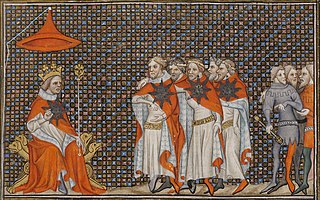
The Order of the Star or Company of the Star was an order of chivalry founded on 6 November 1351 by John II of France in imitation of the Order of the Garter founded in 1348 by Edward III of England. The inaugural ceremony of the order took place on 6 January 1352 at Saint-Ouen, from which it is sometimes called the Order of Knights of the Noble House of Saint Ouen.
The Book of Chivalry was written by the knight Geoffroi de Charny (c.1306-1356) sometime around the early 1350s. The treatise is intended to explain the appropriate qualities for a knight, reform the behavior of the fighting classes, and defend the chivalric ethos against its critics, mainly in clerical circles.

The Battle of Calais took place in 1350 when an English force defeated an unsuspecting French army which was attempting to take the city. Despite a truce being in effect the French commander Geoffrey de Charny had planned to take the city by subterfuge, and bribed Amerigo of Pavia, an Italian officer of the city garrison, to open a gate for them. The English king, Edward III, became aware of the plot and personally led his household knights and the Calais garrison in a surprise counter-attack. The French were routed by this smaller force, with significant losses and all their leaders captured or killed.
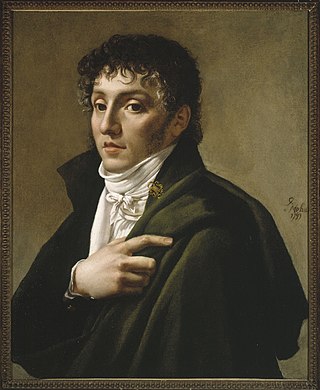
L'oriflamme is an opera in one act with music by Étienne Méhul, Henri Montan Berton, Rodolphe Kreutzer and Ferdinando Paer. It was first staged at the Académie Impériale de Musique on 1 February 1814. The libretto is by Charles-Guillaume Étienne and Pierre-Marie-François Baour-Lormian.

Montjoie Saint Denis! was the battle-cry and motto of the Kingdom of France. It allegedly refers to Charlemagne's legendary banner, the Oriflamme, which was also known as the "Montjoie" and was kept at the Abbey of Saint Denis, though alternative explanations exist. The battle-cry was first known to be used during the 12th century reign of Louis VI of France, the first royal bearer of the Oriflamme.

Sir Eustace de Ribemont was a French nobleman, who was the French standard-bearer in 1346.
